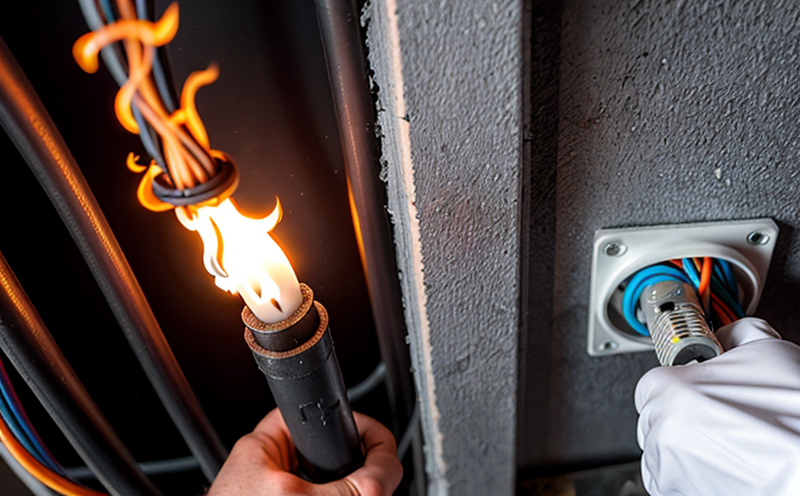IEC 61034-2 Measurement of Smoke Opacity
The IEC 61034-2 standard is a critical component in ensuring fire safety and compliance for electrical cables and wiring. This standard specifically addresses the measurement of smoke opacity, which is an essential parameter to evaluate the performance of fire-resistant materials under controlled laboratory conditions. The primary objective of this test is to quantify how much light is blocked by the smoke produced during the combustion of a specimen.
The process involves subjecting the electrical cable or wiring to standardized fire exposure conditions, typically using a cone calorimeter or equivalent equipment. The apparatus used for this testing ensures precise control over temperature, oxygen concentration, and other parameters that simulate real-world fire scenarios. The resulting smoke opacity is then measured optically through an optical filter placed in front of a light source.
Understanding the implications of smoke opacity is crucial as it directly impacts the visibility in case of a fire emergency. High levels of smoke opacity can significantly impair visibility, making it difficult for individuals to evacuate safely and for firefighters to conduct their duties effectively. This test helps manufacturers design cables that meet stringent safety standards, thereby enhancing public safety.
The acceptance criteria for IEC 61034-2 are based on the maximum allowable opacity levels set by the standard. These levels vary depending on the type of cable and its intended use. For instance, indoor cables used in residential areas might have more stringent limits compared to outdoor or industrial cables due to differences in evacuation times.
The test setup involves several key components: a fire source, an optical filter, and a photometer. The specimen is placed between the fire source and the optical filter, and the amount of light that passes through the smoke produced by the burning cable is measured. This measurement provides a quantitative assessment of the smoke opacity.
In real-world scenarios, this test has significant implications for various stakeholders. Quality managers can use these results to ensure their products meet regulatory requirements and improve product reliability. Compliance officers rely on such data to verify adherence to international standards like IEC 61034-2. R&D engineers leverage the insights gained from this testing to innovate and develop safer, more effective fire-resistant materials.
Furthermore, procurement teams can use these test results as a benchmark for selecting suppliers who provide products that meet stringent safety criteria. By focusing on smoke opacity measurement, organizations can enhance their overall product quality and contribute to public safety.
The IEC 61034-2 standard is widely recognized in the industry for its rigorous approach to fire resistance testing. It ensures that electrical cables and wiring are safe not only during normal use but also under extreme conditions like fires. This standard plays a pivotal role in maintaining high standards of safety, particularly in critical infrastructure where the risk of fire is higher.
Why It Matters
The measurement of smoke opacity according to IEC 61034-2 is crucial for several reasons. Primarily, it ensures that electrical cables and wiring do not compromise safety during a fire by producing excessive smoke. Excessive smoke can lead to reduced visibility, making evacuation more challenging and increasing the risk of injury or death.
From a regulatory perspective, compliance with this standard is mandatory in many regions, particularly for products intended for use in public buildings like schools, hospitals, and commercial offices. Non-compliance can result in fines and legal action. For manufacturers, meeting these standards enhances brand reputation and consumer trust.
The test also aids in product differentiation. By achieving higher ratings on smoke opacity measurement, a company can position its products as superior quality offerings, attracting customers who prioritize safety features.
Moreover, the results of this testing are valuable for insurance purposes. Many insurers consider compliance with standards like IEC 61034-2 when assessing risk and setting premiums. Products that meet these standards may receive lower premiums due to reduced risk.
Industry Applications
Critical infrastructure: Electrical cables in power plants, substations, and transmission lines must pass this test to ensure they do not obstruct visibility during a fire emergency.
Parking garages and underground structures: In these confined spaces, the ability to see clearly is vital for safe evacuation. Cables here should minimize smoke opacity levels.
Offices and commercial buildings: While less critical than public infrastructure, compliance with this standard enhances safety in these environments as well.
Hospitals and other medical facilities: The ability to see clearly can be a matter of life or death. Cables used here must pass the smoke opacity test rigorously.
The results of IEC 61034-2 testing are often documented in reports that detail the specific levels of smoke opacity achieved by different specimens. These reports serve as valuable tools for quality assurance, regulatory compliance, and product differentiation in competitive markets.
Quality and Reliability Assurance
Consistent testing: Regularly conducted tests ensure that the products consistently meet or exceed the required standards over time.
Data-driven decisions: The quantitative data from these tests help in making informed decisions regarding product design, material selection, and production processes.
The test results are not just a compliance check but also an opportunity for continuous improvement. By analyzing the outcomes of IEC 61034-2 testing, manufacturers can identify areas for enhancement and innovate to develop even safer products.
Quality assurance teams rely on these tests to ensure that all batches of cables and wiring meet the stringent requirements set by international standards like ISO, ASTM, EN, IEC, and NFPA. This ensures consistent quality across different production runs and locations globally.





